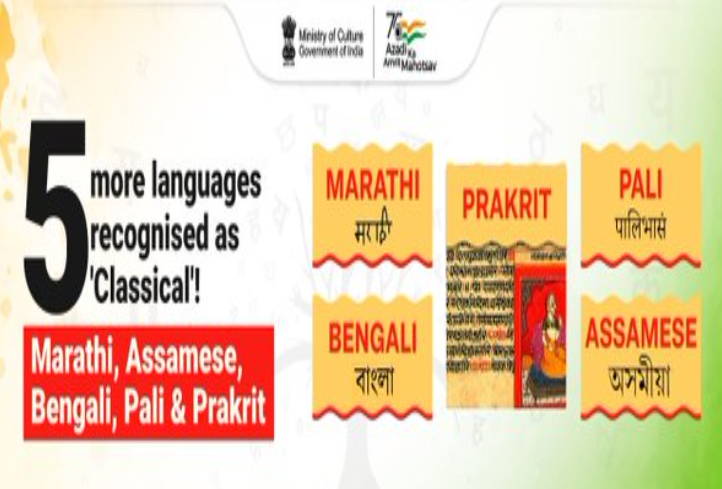India’s 5 New Classical Languages (GS Paper 1, Art & Culture)

Overview
- Recently, the Union Cabinet has designated five additional languages—Marathi, Pali, Prakrit, Assamese, and Bengali—as classical languages of India.
- This move expands the existing list of classical languages, which includes Tamil, Sanskrit, Telugu, Kannada, Malayalam, and Odia.
Background: The Concept of Classical Language
The classification of classical languages was introduced by the Indian government in 2004, responding to demands from various states. Tamil was the first language to receive this status, on October 12, 2004, due to its rich literary tradition and historical significance.
In November 2004, the Ministry of Culture established a Linguistic Experts Committee (LEC) to evaluate proposals for classical language status. The following languages were subsequently recognized:
- Sanskrit: November 25, 2004
- Telugu and Kannada: 2008
- Malayalam: 2013
- Odia: 2014
Latest Criteria for Classical Languages
In July 2024, the LEC revised the criteria for classical status, which now includes:
- High Antiquity: The language must have a recorded history spanning 1,500 to 2,000 years.
- Ancient Literary Heritage: A substantial body of ancient literature recognized as heritage by generations of speakers.
- Epigraphic and Inscriptional Evidence: Documented historical evidence supporting the language's antiquity.
- Diverse Literary Forms: Inclusion of prose texts alongside poetry in its ancient literature.
- Discontinuity with Modern Forms: The language may differ significantly from its contemporary forms or later derivatives.
Addition of 5 New Classical Languages
Following the revised criteria, the committee recommended the addition of five languages that had pending proposals with the Centre for several years:
Marathi
- Historical Context: Evolved from Maharashtri Prakrit, which was spoken in western India. The earliest evidence dates back to a 1st-century BCE stone inscription in Pune, while modern Marathi can be traced to a 739 CE copper-plate inscription in Satara.
- Proposals: The demand for classical status was made by the Maharashtra government in 2013.
Bengali
- Origins: Like Assamese, Bengali evolved from Magadhi Prakrit, with its emergence debated to be between the 6th and 12th centuries.
- Cultural Significance: The language has a rich literary tradition, making it a strong candidate for classical status.
Assamese
- Historical Roots: Also derived from Magadhi Prakrit, Assamese has significant literary contributions and a distinct historical identity.
Pali
- Linguistic Importance: Derived from Magadhi Prakrit, Pali was the language of the Theravada Buddhist Canon and remains influential in Buddhist traditions, particularly in Sri Lanka and Myanmar.
Prakrit
- Cultural Relevance: Refers to a group of Indo-Aryan languages used in ancient India, often contrasted with the more formal Sanskrit. These languages played a crucial role in the spread of religions like Jainism and Buddhism.
Significance of the Classical Tag
The recognition of these languages as classical has profound cultural, academic, and national implications:
- Cultural Preservation: This designation fosters a renewed interest in the study and preservation of these languages and their rich literary traditions.
- Government Support: The Ministry of Education is set to promote these languages through initiatives like establishing Central Universities for Sanskrit and other classical languages, as well as digitizing manuscripts for better accessibility.
- Curriculum Integration: The National Education Policy encourages the inclusion of classical languages in school curricula, helping to instill a sense of pride and cultural identity among students.
- Collaborative Efforts: Enhanced collaboration between the Ministry of Culture, Ministry of Education, and state governments aims to facilitate research and knowledge-sharing in these languages.
- International Recognition: The classical designation elevates the status of these languages on a global scale, attracting interest from scholars and institutions worldwide.
Conclusion
- The addition of Marathi, Pali, Prakrit, Assamese, and Bengali as classical languages marks a significant step in acknowledging India’s linguistic diversity and rich cultural heritage.
- By supporting the preservation and study of these languages, the government not only honors their historical significance but also strengthens national identity and pride.


